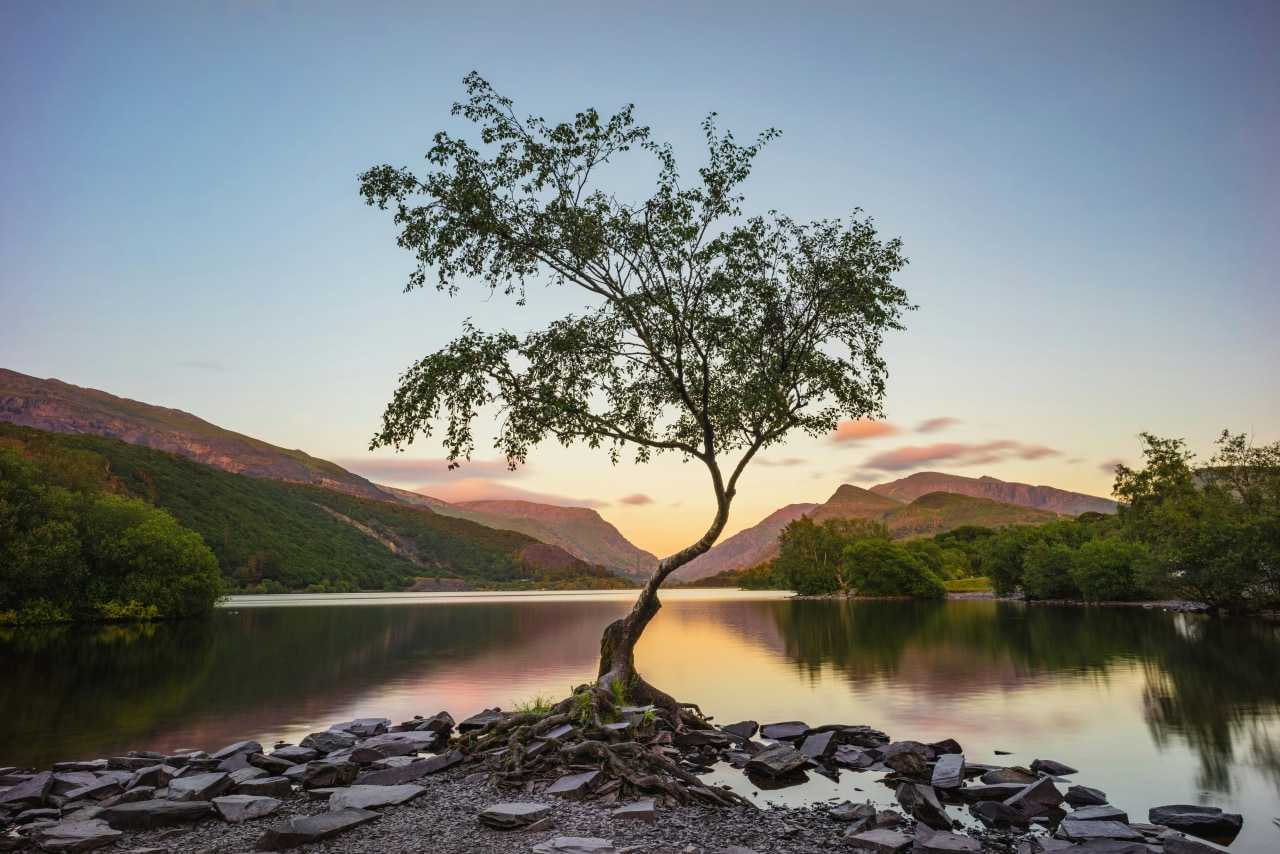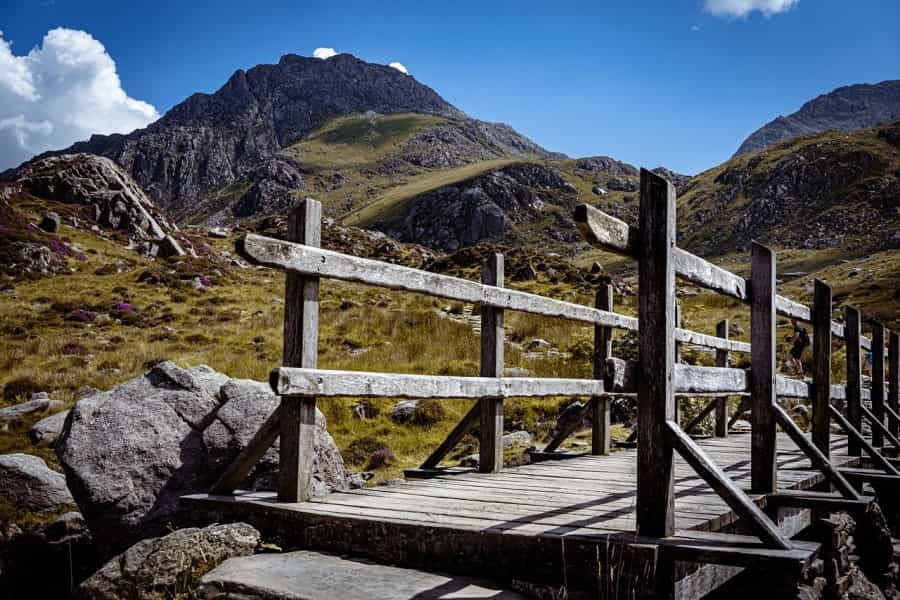Eryri Area Guide

Eryri/Snowdonia National Park is one of Wales’ most famous attractions – it’s the country’s oldest national park, and the largest at 823 square miles (2,130 km2). And the superlatives keep on coming – Eryri/Snowdonia is home to Wales’ tallest mountain and its largest natural lake, as well as the world’s fastest zipline. No wonder it’s also the most popular of Wales’ three national parks, receiving more than four million visitors each year.
Snowdonia National Park was the name the park took when it was established in 1951, but in 2023 the national park authority announced that it would be officially returning to its Welsh name, Eryri, to reflect the fact that Welsh is the first language for more than half the park’s residents.
In practice, both names are still in use, but it’s widely appreciated when visitors use the Welsh name – pronounced EH-roo-ree.
Where is Snowdonia?
Snowdonia/Eryri National Park is in the north west of Wales, and includes parts of both the north coast and the west coast. This means that as well as the mountains, lakes and forested landscapes that it’s famous for, there are also beaches and coastal walks to enjoy, making this a fabulous destination for a break packed full of variety.
There are no motorways in this part of Wales, but the A55 (the North Wales Expressway) provides an easy route to Snowdonia for those in the north of England – from Liverpool or Manchester you can get to Conwy, in the north of the park, with a drive of around an hour and a half. Other good places to stay include Dolgellau or Llanberis for walkers, Blaenau Ffestiniog for adventure seekers and Barmouth or Aberdyfi for coastal days.
The park’s best known attraction is of course Mount Snowdon – the highest mountain in Wales, and of such fame that it gave its name to the entire national park back in the 1950s. These days, it’s known by its Welsh name, Yr Wyddfa (pronounced Err With-va), and it’s still hugely popular – more than half a million people climb the mountain each year.
How many mountains are in Snowdonia?

Snowdonia has 15 mountains measuring 3,000 feet (900 metres) or more – and these are the 15 tallest mountains in Wales too. This mountainous national park is also home to another 60 or so peaks of 2,000 feet or more, which are known as Nuttalls (named after Anne and John Nuttall, who created the list in the 1980s). How many of them will you tick off while you're in Snowdonia?
Snowdonia’s 10 tallest mountains
1. Yr Wyddfa (Snowdon) – 3,560 ft (1,085 m)
2. Carnedd Ugain – 3,493 ft (1,065 m)
3. Carnedd Llywelyn – 3,491 ft (1,064 m)
4. Carnedd Dafydd – 3,426 ft (1,044 m)
5. Glyder Fawr – 3,279 ft (999 m)
6. Glyder Fach – 3,261 ft (994 m)
7. Pen yr Ole Wen – 3,210 ft (978 m)
8. Foel Grach – 3,195 ft (976 m)
9. Yr Elen – 3,155 ft (962 m)
10. Y Garn – 3,107 ft (947 m)
Can you wild camp in Snowdonia?
As a rule, wild camping is not allowed in Snowdonia/Eryri unless you have permission from the landowner. With most of the park's land being privately owned, this means much of it is technically off limits to wild campers. However, people will often tolerate responsible wild camping, as long as it's quiet, unobtrusive and away from main paths and roads (although you should always be prepared to move on respectfully if requested).
If you're an experienced wild camper, you should be able to scope out some suitable potential areas on a map. Favourite Snowdonia wild camping areas among previous visitors include Cwm Idwal, the Tryfan Valley and the upper slopes of Cadair Idris.
Things to do in Snowdonia
Snowdonia/Eryri is an outdoor activity paradise, with a vast array of options for things like hiking, mountain biking, watersports and climbing – plus some unusual adventure activities like Bounce Below’s underground trampoline park and the chance to ride the world's fastest zipline at Zip World Penrhyn Quarry.
Searching for something more relaxing? These landscapes lend themselves to quieter days as well – there are plenty of less challenging walks, peaceful lakes for paddleboarding, and heritage trains to ride. Snowdonia/Eryri is also a Dark Sky Reserve, so it’s a wonderful area for stargazing while camping or glamping.
When to visit Snowdonia
Snowdonia is a year-round destination, so the ‘best time’ to visit depends on what you want from your trip. The best of the weather usually comes from June to September, but these are also the busiest months, so you might want to avoid high-summer travel if you’re not tied to school holidays.
Travelling out of season will give you a more peaceful break, and help ensure the year-round viability of local businesses. Spring and autumn are lovely times to visit Eryri/Snowdonia, for walks among spring flowers or golden-hued trees. Winter brings some more challenging conditions, with many peaks best left to experienced mountaineers, but it’s certainly possible for casual hikers to enjoy crowd-free lower-level walks and cosy pub trips during this time.
It’s worth remembering that the weather is never guaranteed in Wales – downpours can happen at any time, and the sun can be surprisingly strong on mountain peaks even in April. That means it’s always worth packing waterproofs, warm layers and sun cream, whatever the time of year.

Mountain biking in Eryri (Snowdonia)

Snowdonia Water Sports

Climbing in Eryri National Park (Snowdonia)

Adrenaline-Fueled Activities in Snowdonia

Hidden Gems of Snowdonia

Family-Friendly Activities in Snowdonia

Cycling in Snowdonia (Eryri)

Eryri (Snowdonia) Accessible Activities Guide

Walks in Eryri (Snowdonia)

Best hikes in Snowdonia (Eryri)

Cultural Highlights of Eryri National Park

Snowdonia (Eryri) National Park Wildlife